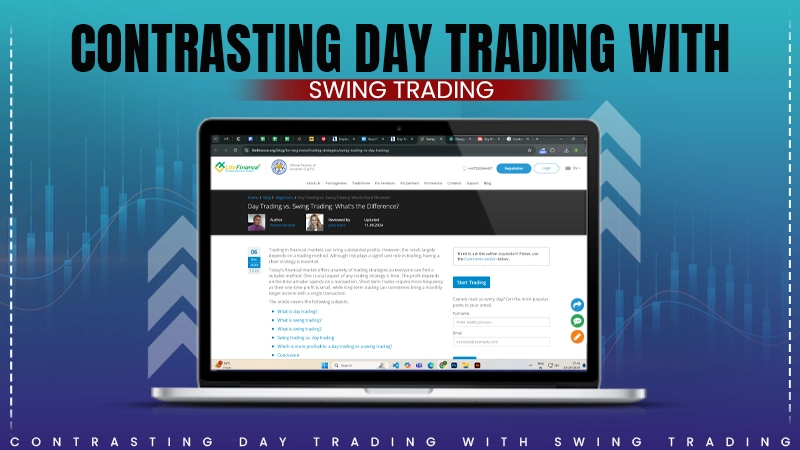Contrasting Day Trading With Swing Trading

There are several approaches to pick from when starting the trading path, each fit to varying degrees of risk tolerance, time commitment, and market understanding. Day trading and swing trading are two well-liked trading strategies that frequently surface in conversation.
Though they are frequently utilized in stocks, Forex, and cryptocurrencies as well as other financial markets, their approaches, timeframes, and risk profiles are very different. The main distinctions of swing trading vs day trading will be discussed in this article to assist you in choosing which approach best fits you.
Day Trading
Day trading is purchasing and selling financial instruments during one trading day. A day trader wants to profit from little price swings all through the day. Usually, day traders avoid exposing themselves to market dangers by not holding holdings overnight, why the market is closed.
Essential traits of day trading:
- Day traders often hold positions for just minutes or hours, however they usually run several trades in one day.
- With the intention of leaving all holdings at the conclusion of the trading day, this approach centers on making rapid gains from intraday market swings.
- Many day traders utilize leverage to magnify their gains, therefore raising their risk as well.
Swing Trading
Conversely, swing trading is a technique used by traders hoping to profit from medium-term price swings by keeping positions for numerous days, weeks, or even months. Swing traders are ready to hang trades overnight and wait for market trends to emerge unlike day traders.
Important attributes of swing trading:
- Usually holding deals for days or weeks, swing traders let market patterns to show themselves.
- Though they take fewer deals than day traders, swing traders often engage in more broadly extensive transactions.
- Swing traders may pay more attention to spotting and profiting from more general market trends than to minor swings.
Time Commitment as a Differentiator
The time required by each approach is one of the most important variations between swing and day trading.
Day trading calls for continuous market monitoring all of the trading day. Those who can commit several hours each day to trade would find it most suitable. Day trading might not be best if you have full-time employment or other obligations since it requires your whole concentration during market hours.
Swing trading has more temporal freedom than other forms of trading. Trade takes several days or even weeks, hence regular monitoring is not necessary. For people with other obligations, swing traders provide a superior choice since they can set stop-loss and take-profit levels and routinely review their deals.
Risk Categories and Reward Possibilities
Day trading and swing trading also have somewhat different risk and return systems. Although all approaches have inherent dangers, the exposure and possible loss vary.
Because of their frequency and usage of leverage, day trading is usually more erratic and might be riskier. Although the possibility for profit is larger, especially if trades go against you rapidly, the likelihood of losing money is also real.
Since swing trading does not depend on quick market changes, it usually entails less risk. Still, keeping positions overnight exposes swing traders to outside variables as geopolitical events or economic pronouncements that might create market gaps. The dangers are more under control even if the possibility for return may not be as instantaneous as day trading.
Common Instruments and Techniques
Though they rely on different tools and indications depending on their time frame, both day traders and swing traders apply technical analysis.
Day trading tools:
- Day traders sometimes rely on 1-minute, 5-minute, or 15-minute charts to identify trading prospects.
- Popular technical indicators for day traders consist of moving averages, Bollinger Bands, and relative strength index (RSI).
- Day traders sometimes employ scalping techniques or try to catch short-term momentum in the market.
Swing trading tools:
- Longer-term charts—4 hours, daily, or even weekly—allow swing traders to see patterns and possible entry and exit opportunities.
- Popular tools available to swing traders are moving averages, Fibonacci retracements, and MACD.
- Using indicators to schedule their bets, swing traders seek for established market trends and try to profit from significant market movements.
Benefits and Drawbacks
For those looking for quick results, day trading is perfect, it eliminates overnight risk since all contracts are closed before the end of the day, offers the possibility to make several little profits throughout the day, and provides the ability to remove But there are also drawbacks, including the necessity for a large time investment, a high-stress atmosphere brought on by constant decision-making, and the possibility of large losses—especially in relation to leverage.
Conversely, swing trading provides the advantage of less time needed and more flexibility. Since consistent market monitoring isn’t required, it also has less stress and could yield more gains by occupying positions over multiple days or weeks. Still, it usually takes more time to achieve gains than day trading and runs the danger of being caught in overnight and weekend volatility.
Deciding Between Swing and Day Trading
Your lifestyle, risk tolerance, and time availability will finally determine whether you choose day trading or swing trading. Day trading would fit you if you have time to commit during market hours and like fast-paced trading. Swing trading may be a better fit, though, if you have a longer time horizon, less available time, or would want to ride market trends.
Important elements to think about:
- Day trading may provide the adrenaline surge you’re looking for if you can manage high-risk, high-reward scenarios. The risk profile of swing trading is more subdued.
- For those with little time, swing trading is best, day trading calls for a full-time dedication to market monitoring.
- Day trading gives the possibility for faster profits, swing trading lets you make more significant gains over time.
Though they use distinct techniques, day trading and swing trading are both successful ways for earning money in the financial markets. While swing trading lets you relax with deals spanning days or weeks, day trading requires a major time commitment, greater risk tolerance, and fast decision-making. Whether your trading style fits your personal goals, risk tolerance, and availability, you should match the fast-paced world of day trading or the more strategic character of swing trading.












